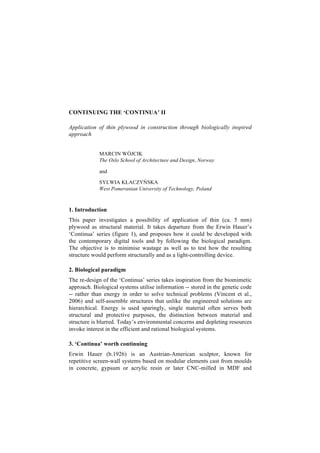Report
Share
Download to read offline

Recommended
Solar cell absorber Kesterite- type Cu2ZnSnS4 (CZTS) thin films have been prepared by Chemical Bath Deposition (CBD). UV–vis absorption spectra measurement indicated that the band gap of as-synthesized CZTS was about1.68 eV, which was near the optimum value for photovoltaic solar conversion in a single-band-gap device. The polycrystalline CZTS thin films with kieserite crystal structure have been obtained by XRD. The average of crystalline size of CZTS is 27 nmENERGY GAP INVESTIGATION AND CHARACTERIZATION OF KESTERITE CU2ZNSNS4 THIN FIL...

ENERGY GAP INVESTIGATION AND CHARACTERIZATION OF KESTERITE CU2ZNSNS4 THIN FIL...International Journal of Technical Research & Application
Recommended
Solar cell absorber Kesterite- type Cu2ZnSnS4 (CZTS) thin films have been prepared by Chemical Bath Deposition (CBD). UV–vis absorption spectra measurement indicated that the band gap of as-synthesized CZTS was about1.68 eV, which was near the optimum value for photovoltaic solar conversion in a single-band-gap device. The polycrystalline CZTS thin films with kieserite crystal structure have been obtained by XRD. The average of crystalline size of CZTS is 27 nmENERGY GAP INVESTIGATION AND CHARACTERIZATION OF KESTERITE CU2ZNSNS4 THIN FIL...

ENERGY GAP INVESTIGATION AND CHARACTERIZATION OF KESTERITE CU2ZNSNS4 THIN FIL...International Journal of Technical Research & Application
More Related Content
Similar to POSTER DCC2014 MWSK s
Similar to POSTER DCC2014 MWSK s (20)
Nature-inspired Solutions for Engineering: A Transformative Methodology for I...

Nature-inspired Solutions for Engineering: A Transformative Methodology for I...
Design for Additively Manufactured Structure An Assessment

Design for Additively Manufactured Structure An Assessment
Perfomance evaluation on light transmitting concrete (translucent concrete)

Perfomance evaluation on light transmitting concrete (translucent concrete)
International Journal of Engineering Research and Development

International Journal of Engineering Research and Development
Finite ElementAnalysis of Doubly Curved Thin Concrete Shells

Finite ElementAnalysis of Doubly Curved Thin Concrete Shells
Future_directions_for_nonconventional_and_vernacul.pdf

Future_directions_for_nonconventional_and_vernacul.pdf
Experimental Investigation and Analysis A Mechanical Properties of Hybrid Pol...

Experimental Investigation and Analysis A Mechanical Properties of Hybrid Pol...
Journal of Building Material Science | Vol.5, Iss.1 June 2023

Journal of Building Material Science | Vol.5, Iss.1 June 2023
Engineering Nanocellulose films and their composites via spray coating

Engineering Nanocellulose films and their composites via spray coating
nanocellulose based medicine 2017 Rev 3rd Article.pdf

nanocellulose based medicine 2017 Rev 3rd Article.pdf
POSTER DCC2014 MWSK s
- 1. CONTINUING THE ‘CONTINUA’ II Application of thin plywood in construction through biologically inspired approach MARCIN WÓJCIK The Oslo School of Architecture and Design, Norway and SYLWIA KŁACZYŃSKA West Pomeranian University of Technology, Poland 1. Introduction This paper investigates a possibility of application of thin (ca. 5 mm) plywood as structural material. It takes departure from the Erwin Hauer’s ‘Continua’ series (figure 1), and proposes how it could be developed with the contemporary digital tools and by following the biological paradigm. The objective is to minimise wastage as well as to test how the resulting structure would perform structurally and as a light-controlling device. 2. Biological paradigm The re-design of the ‘Continua’ series takes inspiration from the biomimetic approach. Biological systems utilise information -- stored in the genetic code -- rather than energy in order to solve technical problems (Vincent et al., 2006) and self-assemble structures that unlike the engineered solutions are hierarchical. Energy is used sparingly, single material often serves both structural and protective purposes, the distinction between material and structure is blurred. Today’s environmental concerns and depleting resources invoke interest in the efficient and rational biological systems. 3. ‘Continua’ worth continuing Erwin Hauer (b.1926) is an Austrian-American sculptor, known for repetitive screen-wall systems based on modular elements cast from moulds in concrete, gypsum or acrylic resin or later CNC-milled in MDF and
- 2. limestone (Hauer, 2004). These are time and energy consuming and produce waste. ‘Design 3’ (1952) from the ‘Continua’ series would be applicable for external light-breaking building envelopes (Kłaczyńska, 2013). Figure 1 - Erwin Hauer’s ‘Design 3’. Figure 2 and 3 - proposed solution. 4. Proposed approach The proposed solution (figure 2 and 3) is based on sheet material bent to form and thus achieving strength. Thin plywood is lightweight, durable, flexible and based on a renewable resource. Tension in bending is induced by threaded bars. The cross shape of the panels provides for achieving double curvature. The distribution of convex vs. concave panels regulates the overall stiffness. CNC laser cutter enables variation without extra production time. The system uses the method of parametric design, where sizes of the openings and amplitudes of the wave are variable. That allows for changing the geometry in response to the geometrical, structural and environmental factors. Hierarchically, global form is controlled locally at a level of a single unit, that being dependent on the combination of material properties and geometry. By doing so much less material, energy and time are used to produce a final piece. This solution required reconfiguration of the modules, but the geometrical features of the original ‘Design 3‘ are sustained. Further development of the system includes providing for self- support through the overall geometry, e.g. shells, as well as adding material criteria as a variable parameter by varying the number of plies in response to the curvature. References Hauer, E: 2004, Erwin Hauer: continua : architectural screens and walls, Princeton Architectural Press, New York. Kłaczyńska, S: 'Transition Zone' jako opozycja dla ściany. In: T Wagner, ed. Modernity in Architecture. Integration - Identification - Innovation, 2013. Gliwice: Wydział Architektury Politechniki Śląskiej w Gliwicach, pp. 107-122. Vincent, JFV, Bogatyreva, OA, Bogatyrev, NR, Bowyer, A and Pahl, A-K: 2006, Biomimetics: its practice and theory, Journal of The Royal Society Interface, 3(9), pp. 471-482.